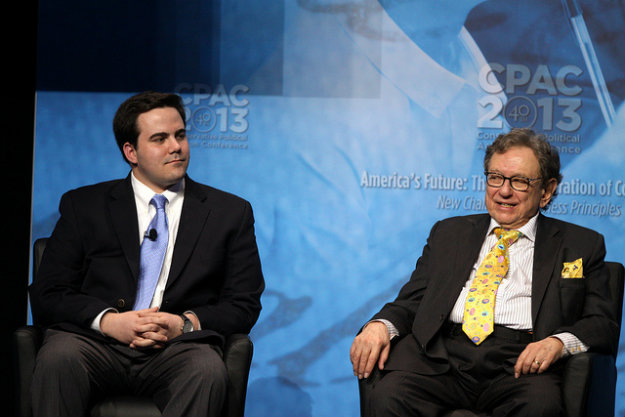
“Storm the Capitol” event at the governor’s residence in St. Paul, Minn., on Jan. 6. Photo (cc) 2021 by Chad Davis.
Previously published at GBH News.
All of a sudden, our crisis of democracy has moved to center stage. Building since 2016, when Donald Trump refused to say whether he’d accept the results of the election if he lost, and boiling since the Jan. 6 insurrection, the rising specter of authoritarian rule is now a lead story in much of our media.
From The Washington Post to Politico, from The Philadelphia Inquirer to The Boston Globe, from CNN to public radio’s “On the Media,” the conversation for the past week has revolved around the likelihood that Trump will run for president in 2024 — and the very real possibility that Republican functionaries at the state level and in Congress will reinstall him in the White House regardless of how the election actually turns out.
Perhaps the most chilling assessment was offered in the Post by Robert Kagan, a “Never Trump” conservative who began his must-read 5,800-word essay like this: “The United States is heading into its greatest political and constitutional crisis since the Civil War, with a reasonable chance over the next three to four years of incidents of mass violence, a breakdown of federal authority, and the division of the country into warring red and blue enclaves.”
Appearing on CNN’s “Reliable Sources,” Yale historian Timothy Snyder, the author of the 2017 book “On Tyranny,” said it was long past time for the press to cover Trump and Trumpism as an existential threat to democracy.
“If we’re not prepared for the attempt for people to take power undemocratically in 2024, then we’re just at this point pathetically naive,” he said. “Preparing for that and getting the facts out so that people can prepare for that and prevent it is what … journalism should be doing.”
Kagan, Snyder and others are right to be alarmed. But what accounts for this moment of media synchronicity? Why have they suddenly gone DEFCON 1 after months and years of covering the Trump movement all too often as a bunch of economically anxious white men in Ohio diners? I think there are three precipitating factors.
• First, Bob Woodward and Robert Costa’s new book, “Peril,” makes it clear that Trump was actively involved in trying to overturn the election in ways that we didn’t quite understand previously. Perhaps the most bizarre and disturbing of their findings is that a discredited lawyer, John Eastman, concocted a scheme for Vice President Mike Pence to overturn the results of the election. If Pence had wavered, who knows what might have happened?
• Second, the results of the fraudulent Arizona “audit” actually gave President Joe Biden a bigger lead over Trump than he had previously — and it didn’t make a bit of difference. As Will Bunch of The Philadelphia Inquirer observed, copycat attempts are now under way in Texas and Pennsylvania. It’s now obvious, if it wasn’t before (actually, it was), that the purpose of these ridiculous exercises is not to prove that Trump won but to keep his supporters stirred up and angry.
• Third, University of California Irvine law professor Rick Hasen, who’s been ringing the democracy alarm for years, recently published a paper and helped run a conference that generated widespread attention. That, in turn, led to an interview with Hasen by Politico Magazine and an appearance on “On the Media.”
Hasen bluntly described the threat in his interview with Politico, saying that the widespread, false belief among Republicans that the 2020 election was stolen could lead them to steal the 2024 election.
“The rhetoric is so overheated that I think it provides the basis for millions of people to accept an actual stolen election as payback for the falsely claimed earlier ‘stolen’ election,” Hasen said. “People are going to be more willing to cheat if they think they’ve been cheated out of their just desserts. And if [you believe] Trump really won, then you might take whatever steps are necessary to assure that he is not cheated the next time — even if that means cheating yourself. That’s really the new danger that this wave of voter fraud claims presents.”
Politico media critic Jack Shafer, trying to be his usual contrarian self, argued that Trump’s increasingly unhinged behavior and Republican attempts to rig the 2024 election through voter suppression and outright theft by state legislatures they control is actually a sign of weakness, not of strength.
“By signaling an attempt to regain power by any means necessary,” Shafer wrote, “Trump essentially confesses that Trumpism is not and is not likely to become a majoritarian movement.” He added that a fraudulent Trump victory would essentially amount to a coup, which “would only inspire a counter-coup by the majority, and maybe a counter-counter coup, and a counter-counter-counter coup. Trump is crazy enough to invite this fight, and narcissistic enough not to care what it does to the country. But is he shrewd enough to win it?”
Shafer is right that a Trump coup would lead to outrage on the part of the majority. But what would that look like? It could get incredibly ugly, as Kagan warned. The best way to deal with the Republicans’ assault on democracy is to make sure it fails. Sadly, the Democrat-controlled Congress can’t do much about it unless they abolish the filibuster, regardless of how Harvard Law School professor Laurence Tribe and his colleagues, writing in The Boston Globe, might wish otherwise. And Sens. Joe Manchin and Kyrsten Sinema show no signs of yielding.
So what can and should the media do? Their current focus on the overriding crisis of our time is welcome and long overdue. From the false balance of focusing on lesser stories like Democratic bickering over the infrastructure bills to the situation at the border, the media have demonstrated a maddening impulse to return to business as usual following the chaos of the Trump years.
At the same time, though, the press’ influence is limited. Roughly speaking, 60% of the country is appalled by Trump and 40% is in thrall to him. But thanks to inequities in the Electoral College and the Senate, gerrymandering in the House and increasingly aggressive attempts to disenfranchise Democratic-leaning voters, the 40% may well succeed in shoving aside the 60%.
The press needs to tell that story, fearlessly and fairly. But let’s not kid ourselves. It’s not going to penetrate Fox News, Breitbart or Facebook. In the end, there may be little that journalism can do to stop our slide into autocracy.


